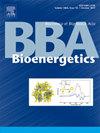功能分子探针在霍乱弧菌Na+易位nadh -泛醌氧化还原酶NqrB亚基中的精确引入。
IF 2.7
2区 生物学
Q2 BIOCHEMISTRY & MOLECULAR BIOLOGY
引用次数: 0
摘要
Na+易位nadh -泛醌氧化还原酶(Na+-NQR)是包括霍乱弧菌在内的许多致病菌呼吸链中的关键酶。NqrB亚基(Met1-Lys54)的柔性胞质n端区域可能在相邻NqrA的最终UQ还原中起重要作用,是特异性抑制剂的靶点。如果我们能够开发出一种新的方法,能够精确地将功能探针分子(如荧光探针)引入n端区域,这可能会导致新的实验方法来监测该区域的动态结构变化。我们之前的研究表明,可以从korormicin a模板化的合成配体中释放的亲电化学基团可以主要通过配体定向(LD)取代引入亲核的Lys22中作为“立足点”,但随后通过Cu+催化的点击化学将功能探针分子偶联到立足点需要破坏酶。因此,我们现在报道了通过两步共轭技术将功能分子无损地偶联到n端区域:首先,使用新的korormicin a模板配体(BEK-1)通过LD取代精确地引入含有环应变环丙烯的立足标记;其次,通过反向电按需diels - alder型点击化学将含有四嗪的荧光探针分子与引入的环丙烯直接偶联。蛋白质序列分析表明,荧光探针可以附着在Lys19、His20或Lys22上。在不同抑制剂的存在下,荧光探针的共轭程度大约减半,这表明抑制剂的结合诱导了残基周围的结构变化。本文章由计算机程序翻译,如有差异,请以英文原文为准。
Pinpoint introduction of functional molecular probe into the NqrB subunit of Na+-translocating NADH-ubiquinone oxidoreductase from Vibrio cholerae
The Na+-translocating NADH-ubiquinone oxidoreductase (Na+-NQR) is a key enzyme in the respiratory chain of numerous pathogenic bacteria, including Vibrio cholerae. The flexible cytoplasmic N-terminal region of the NqrB subunit (Met1–Lys54), which may play an important role in the final UQ reduction at the adjacent NqrA, is the target of specific inhibitors. If we can develop a new method that enables pinpoint introduction of functional probe molecules (such as fluorescent probes) into the N-terminal region, this could lead to new experimental ways of monitoring dynamic structural changes of the region. We previously showed that an electrophilic chemical group, which can be released from korormicin A-templated synthetic ligand, can be predominantly introduced into nucleophilic Lys22 as a “foothold” via ligand-directed (LD) substitution, but the subsequent conjugation of a functional probe molecule to the foothold by Cu+-catalyzed click chemistry required destruction of the enzyme. Accordingly, we now report the nondestructive conjugation of the functional molecule into the N-terminal region via a two-step conjugation technique: first, pinpoint introduction of a foothold tag containing a ring-strained cyclopropene by LD substitution using a new korormicin A-templated ligand (BEK-1) and second, direct conjugation of a fluorescent probe molecule containing tetrazine with the introduced cyclopropene by inverse electron-demand Diels-Alder-type click chemistry. Protein sequence analyses revealed that the fluorescent probe is attached to Lys19, His20, or Lys22 in the region. The extent of conjugation of the fluorescent probe was approximately halved in the presence of different inhibitors, suggesting that the inhibitor binding induces structural changes around the residues.
求助全文
通过发布文献求助,成功后即可免费获取论文全文。
去求助
来源期刊

Biochimica et Biophysica Acta-Bioenergetics
生物-生化与分子生物学
CiteScore
9.50
自引率
7.00%
发文量
363
审稿时长
92 days
期刊介绍:
BBA Bioenergetics covers the area of biological membranes involved in energy transfer and conversion. In particular, it focuses on the structures obtained by X-ray crystallography and other approaches, and molecular mechanisms of the components of photosynthesis, mitochondrial and bacterial respiration, oxidative phosphorylation, motility and transport. It spans applications of structural biology, molecular modeling, spectroscopy and biophysics in these systems, through bioenergetic aspects of mitochondrial biology including biomedicine aspects of energy metabolism in mitochondrial disorders, neurodegenerative diseases like Parkinson''s and Alzheimer''s, aging, diabetes and even cancer.
 求助内容:
求助内容: 应助结果提醒方式:
应助结果提醒方式:


